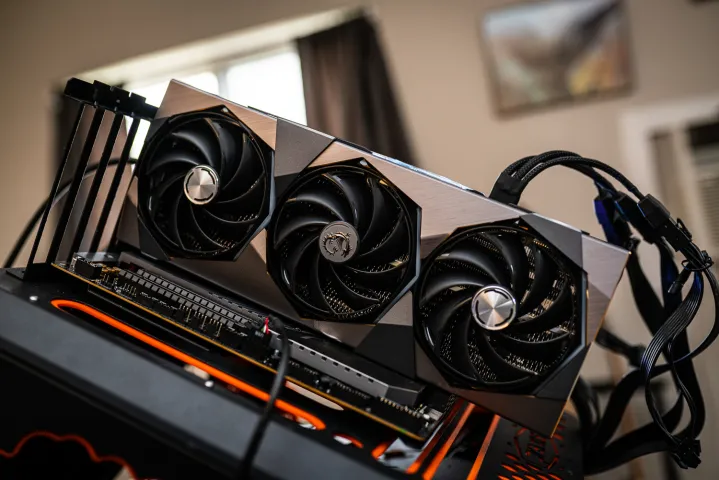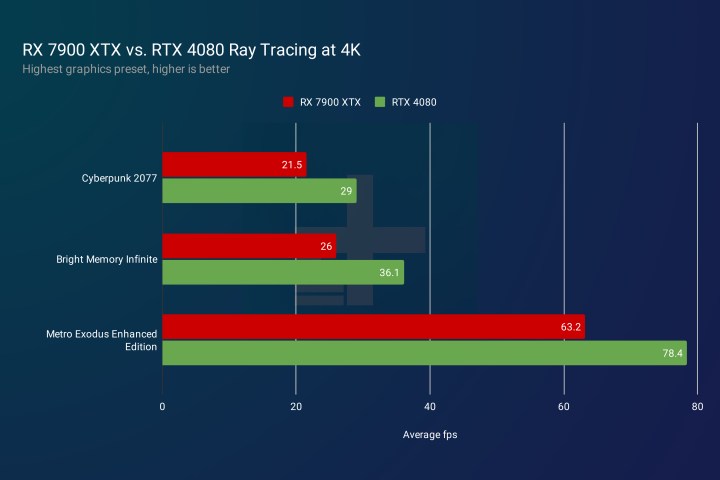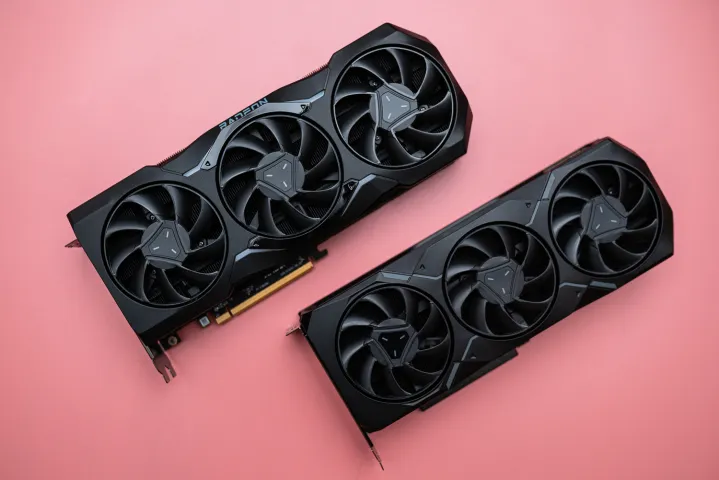
After championing AMD and considering using it in my next build, I still ended up buying one of Nvidia’s best graphics cards — although arguably, the GPU in question is also among Nvidia’s worst. Sure, it’s a powerful card, but in terms of value, it’s probably one of the worst options I could have gone with.
I’m talking about the RTX 4080. There’s no doubt it can blitz through any game you can throw at it, as you can read in our RTX 4080 review, but it’s also $1,200 — a full $500 more than last-gen’s RTX 3080.
Do I regret it? No, not at all. I still believe that my poor-value Nvidia GPU is a better deal than whatever AMD had to offer at the time. But if I was making my decision now, AMD may have finally made me think twice.
I really wanted it to be AMD

When I first heard about AMD’s Radeon RX 7900 XTX, I was excited and all but ready to jump ship after years of buying only Nvidia. I didn’t always revert back to Team Green out of some kind of brand loyalty, or at least I’d like to think that it didn’t play much of a part. Still, having been disappointed by AMD in the past, I didn’t do much to challenge the fact that Nvidia simply had the better GPUs for many years in a row. That sentiment stopped being true with the advent of RDNA 2, and AMD was once again on my radar. The RX 7900 XTX solidified my wish to go for the underdog and give AMD another chance.
And yet, here I am, the (mildly) proud owner of an RTX 4080 — a GPU where the numbers really just don’t add up. It’s expensive, but not quite powerful enough to justify the inflated price tag. Have I lost my mind? You might make that argument, but for the most part, I made an informed decision and bought the RTX 4080 knowing all of the caveats.
Yes, I still think that it was the better choice than the RX 7900 XTX.
With that said, I chose the RTX 4080 somewhat begrudgingly, and that’s largely down to Nvidia’s approach to pricing its GPUs. Market domination has made Nvidia a little too comfortable, or so it seems, because not only does it have a pretty outrageous pricing strategy, but it also stands by it and doesn’t seem eager to make any changes.
Unfortunately, the RX 7900 XTX lacked a few of the reasons that make the RX 7800 XT an interesting pick, which is why I was ultimately tempted back in Nvidia’s direction.
Not quite there yet

The RX 7900 XTX is a great GPU, and it actually outpaces the RTX 4080 in some games. However, in our review of the card, you’ll see that it turned out to be around 6% slower than the RTX 4080 at 4K with ray tracing enabled. In a way, that’s a great result, given AMD’s less-than-stellar record where ray tracing is involved, but it’s not exactly a dealbreaker in either direction. These two cards are fairly comparable.
Nvidia has the upper hand with Deep Learning Super Sampling 3 (DLSS 3), though. This upscaling technology that generates entire frames instead of just pixels is powerful enough to let an RTX 4070 achieve higher frames per second than an RTX 4090.
It’s not available in every game, but it’s mighty impressive, and while it’s not without flaws, it’s still far better than AMD’s FidelityFX Super Resolution 2 (FSR 2).
By now, AMD also has FSR 3, which marks yet another step in the right direction. However, unlike DLSS 3, FSR 3 is available on any GPU. It’s nice of AMD to make it far more accessible, but it also means that you don’t necessarily need to buy an AMD graphics card to take advantage of it. DLSS 3 is exclusive to Nvidia’s RTX 40-series, and some of the GPUs in that lineup are little more than vessels for Nvidia’s AI-driven frame generation — take the RTX 4060 Ti as a prime example.
All that put together means that we’ve got two GPUs that are close in performance, but only one of them has access to Nvidia’s tech stack. Ray tracing becomes nice to have at this level, and DLSS 3 is enticing if it’s not too expensive to get.

That’s the problem — the price gap between the RX 7900 XTX and the RTX 4080 just wasn’t big enough for me to justify giving up on DLSS 3 and improved ray tracing. The recommended list price for the RTX 4080 sits at $1,200, while the 7900 XTX is priced at $1,000. In practice, you can find many models of the RTX 4080 at around $1,100, while the RX 7900 XTX is about $950 to $1,020. When you’re already spending over $2,000 on a computer, adding an extra $100 to get a more impressive GPU feels like less of a problem than it does in a budget-oriented PC build.
If there’s one thing I regret, it’s not saving up more and doubling down on my budget-breaking adventure to just get the (surprisingly better value) RTX 4090. On the other hand, I, like most people, really don’t need that kind of a GPU.
Had the RX 7900 XTX been cheaper, it likely would have been more popular. I know I wouldn’t have hesitated if it was in the $800 to $850 range. Nvidia’s RTX 4080 was too expensive to begin with, so if AMD kept things reasonable in turn, it would have made much more sense to snub Nvidia and go for AMD. Unfortunately, both manufacturers went with high prices, and I went with the controversial RTX 4080 despite my earlier plans.
That brings us back to the new RX 7800 XT. It’s not the class of GPU I was looking at for my next PC build, but it’s clear AMD didn’t take the pricing bait this time around.
AMD is finally heading in the right direction

The RX 7800 XT is the GPU I’ve been hoping to see for a long time. At just $500, it shows a commanding lead over Nvidia’s RTX 4070, not to mention the RTX 4060 Ti. Running at 1440p, which is the card’s intended resolution, it beats the 4070 by an average of 9%. It also outpaces its Nvidia counterpart by 6% at 4K. That may not sound huge, but the RX 7800 XT is $100 cheaper. And at this price, $100 makes a huge difference.
We’re also seeing better results in ray tracing at 1440p, and that’s encouraging. AMD’s climb up the ray tracing ladder has been rather slow, but while the 7800 XT is still behind the RTX 4070 in that regard on average, there are games where it keeps up. It maintains an average of 74 frames per second (fps) in Returnal with ray tracing enabled at 1440p, which is more than playable. Nvidia’s minuscule lead isn’t a problem here — it hits 76 fps on average, which makes no difference during gameplay. Resident Evil 4 pits the two cards against each other in a similar way, with the two achieving the same 93.3 fps average.
Cyberpunk 2077 is one game where AMD still lags behind in a big way, reaching 27 fps on average compared to Nvidia’s 38.8 fps. Despite that result, I’m still impressed with AMD’s improvement in the ray tracing department.
You’d expect a $1,000 GPU to be able to handle 4K and ray tracing with ease, which is where the RX 7900 XTX proved to be a disappointment. However, when a GPU that’s half the price manages to beat a competitor that’s priced higher, it’s a victory to be celebrated.
There’s also the ongoing VRAM dilemma. While the RX 7900 XTX has an impressive 24GB of video memory, which is the equivalent of Nvidia’s flagship RTX 4090, it makes less of a difference at this level. The RTX 4080 has much less (16GB), but it still has plenty to handle even the most demanding games. However, at these lower GPU tiers, both the 7800 XT and the 7700 XT shine when compared to their starved-for-VRAM counterparts. The RTX 4070 skirts by with 12GB, but you’re stuck with only 8GB with anything lower.

The RX 7800 XT is what the RX 7900 XTX should have been. It’s great value, so much so that it’s now hard to recommend any other graphics card at this price point. It performs really well for the price, it’s not a letdown in terms of ray tracing, and it will have the same access to FSR 3 as every other AMD GPU. At $500, it’s refreshing to see in the current GPU landscape that’s filled with overpriced cards.
With that said, I still don’t regret my overpriced RTX 4080.
Why? Because AMD still doesn’t have an enticing counterpart at that performance tier. I wanted a GPU capable of handling 4K gaming, ray tracing at high frame rates, and all those other bells and whistles. The RX 7900 XTX can’t give me that while simultaneously being significantly cheaper than the graphics card I chose in the end.
The AMD Radeon RX 7800 XT is definitely a step in the right direction for AMD, and it is exactly why I’m not upset about AMD potentially skipping the high-end segment in its next-gen graphics cards. If I wanted a 1440p GPU, I wouldn’t have thought twice and I’d have gone for AMD this time around.
As it is now, I’m sticking to my terrible value RTX 4080 and hoping that AMD will keep up this trend going forward, because the RX 7800 XT is really the way to go.




